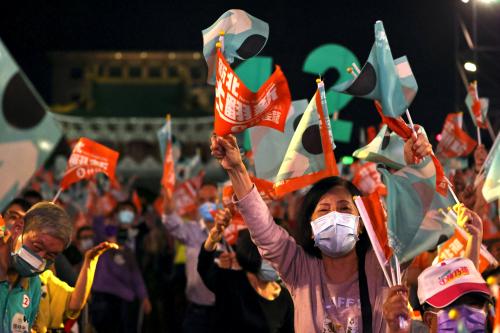In the run-up to Taiwan’s 2024 presidential election, the Brookings Center for East Asia Policy Studies solicited contributions from two leading voices from a rising generation of thought leaders from different perspectives to assess the role of the United States in cross-Strait relations. The authors, who belong to the Kuomintang and the Democratic Progressive Party respectively, were asked to offer their own independent analysis, and do not speak on behalf of the political party that they support. The goal of this piece and its companion is to highlight some of the policy differences and similarities among Taiwan’s major political parties, in order to contribute to elevating public understanding of the issues at play in Taiwan’s upcoming election. This piece is part of the Taiwan-U.S. Quarterly Analysis series, which features the original writings of experts with the goal of providing a range of perspectives on developments relating to Taiwan.
The strategic environment in East Asia has undergone a significant transformation due to China’s increasing assertiveness toward Taiwan, coupled with its evident ambition to challenge the global order. This has led to escalating competition between China and the United States.
While U.S. intelligence believes that Chinese President Xi Jinping has directed the People’s Liberation Army to be ready for potential military operations against Taiwan by 2027, varying assessments exist regarding the imminence or preventability of a conflict in the Taiwan Strait. Certain analysts propose that China might possess the capability to initiate an attack on Taiwan by 2025. Alternatively, the risk of conflict could escalate as Xi nears the conclusion of his third term in 2027 and endeavors to solidify his legitimacy. On the other hand, some argue that Beijing’s course of action hinges on the prospect of “peaceful unification” with Taiwan and whether the perceived benefits outweigh the costs.
Some in the United States indeed share a sense of urgency regarding China’s ambitions and its potential for using force against Taiwan. The mounting concerns within Washington about the military disparity between Taiwan and China have prompted the United States to bolster Taiwan’s self-defense capabilities on all fronts.
Analysts believe that Taiwan is not adequately prepared militarily, making the enhancement of Taiwan’s defense capabilities a top priority. The Biden administration, therefore, has not only increased its support to Taiwan via various multilateral diplomatic initiatives but also significantly fortified its defense assistance through arms sales, joint training, and an increased military presence around Taiwan.
Additionally, other analysts remain concerned over the degree of Taiwan’s reliance on the Chinese market. From their perspective, Taiwan’s dependence on the Chinese economy leaves it vulnerable to Beijing’s economic coercion and compromises its ability to defend against China’s assertiveness. Likewise, the resilience of Taiwan’s semiconductor supply chain dovetails with the core interests of the world economy. Concerned for its own supply chain resilience, the United States has encouraged Taiwan to diversify its trade dependency away from China and is strengthening Taiwan’s economic resilience by initiating trade agreements.
The Tsai administration and the ruling Democratic Progressive Party (DPP) government have also underscored the significance of fortifying Taiwan’s national resilience. Over the past seven years, they have enacted significant policy changes to strengthen Taiwan’s national defense capabilities, reduce Taiwan’s overreliance on the Chinese economy, and bolster Taiwan’s relations with like-minded allies. This has included annually increasing Taiwan’s defense budgets and investment in the development of indigenous weapon systems, such as combat drones, jet trainer airplanes, missile defense systems, and navy vessels. In order to strengthen Taiwan’s combat forces, the Tsai administration has also made the difficult political decision to reintroduce one-year conscription and implement reforms on the mobilization and training of the reserve forces.
The Tsai administration has also sought to decrease Taiwan’s economic dependency on China by attempting to have Taiwan’s businesses increase their investments in Southeast Asia under its New Southbound Policy. The administration has also enhanced its economic cooperation with the United States and its European counterparts to ensure stronger and more resilient supply chains. Notably, Taiwan recently signed the historic U.S.-Taiwan Initiative on 21st Century Trade with the United States despite strong protests from Beijing. Diplomatically, the Tsai administration has fostered closer ties with like-minded democratic partners, moving away from a singular focus on Taiwan’s relations with China.
These policies were constituted against the crucial backdrop of China’s escalating military threat and its growing assertiveness toward Taiwan. This does not imply, however, that Taiwan would forgo any opportunity for dialogue across the Taiwan Strait. Statements from the Tsai administration consistently support meaningful dialogue based on reciprocity and mutual respect, without imposing political preconditions. This stance persists despite China severing official channels for cross-Strait dialogue in 2016.
Certainly, Taiwan is not enthusiastic about the prospect of a military conflict erupting in the Taiwan Strait. War offers no benefits to anyone. Hence, peace, stability, and maintaining the status quo in the Taiwan Strait remain central priorities for the current Tsai administration, aligning with the best interests of the Taiwanese people.
In the United States, some believe Washington’s “One China” policy and its commitment to Taiwan based on the Taiwan Relations Act continue to serve as a broad framework for steering Taiwan-U.S. relations. Moreover, debates surrounding “strategic ambiguity” versus “strategic clarity” remain heated in Washington, while President Joe Biden has made four public statements on his willingness to militarily defend Taiwan. Notably, such debates over the United States’ Taiwan policy also occur among foreign policy wonks in Taiwan.
However, the Tsai administration has not officially taken a stance on this issue. In my observation, Taiwan-U.S. relations have progressed in a more substantive direction. Both Taipei and Washington have acknowledged the importance of their close coordination in managing regional risks in recent years.
Nevertheless, this does not mean that there are no differences in views between Taiwan and the United States. In fact, there is ongoing debate on the symbolic versus substantive dimensions of their relationship, particularly concerning the complexities of risk management.
Certain perspectives argue that emphasizing symbolic improvements in Taiwan-U.S. relations may result in heightened risks to regional stability due to China’s increasing assertiveness. The United States, therefore, tends to consider progress in enhancing Taiwan’s actual defense capabilities to be of substantive significance.
Notably, Taiwan does not adopt a diplomatic strategy that favors symbolism over substance in its interactions with the United States. More than anything, leaders in the country prioritize efforts to strengthen its defense preparations, its economy, and other crucial aspects through meaningful cooperation with the United States.
However, there is a disparity in understanding between Taiwan and the United States concerning symbolic versus substantive issues, specifically in their perceptions of the battleground for countering Chinese aggression.
For Taiwan, China’s threat extends beyond military, economic, and diplomatic avenues. That is, there exists another significant battleground: cognitive warfare — in which China aims to erode the resolve of the Taiwanese people for their self-defense by propagating concerns about their isolation and diminishing international commitment and support for Taiwan.
While the United States considers whether Taiwan has a strong and resilient will to defend itself as a criterion driving U.S. policy, many in Taiwan are concerned with how to strengthen the Taiwanese people’s determination to resist China’s coercion and how to enhance their confidence via support from the international community. Given Taiwan’s decades-long isolation and Beijing’s cognitive warfare, in my observation, some in Taiwan believe such confidence requires not only domestic confidence-building efforts but also visible signals to the Taiwanese public from international partners. Therefore, the support voiced by the international community serves multiple purposes: as a means to counter China’s attempts to divide Taiwan’s society, as well as a signal of shifts toward an international environment that limits the space for Chinese coercion.
In this analysis, in order to secure Taiwan against potential Chinese aggression and to maintain peace and stability through fostering alliances in the region, it is essential for Taipei and its international partners to bridge this gap in how they perceive the cognitive battlefield and to understand the value of their messaging in the international arena — which is by its nature visible yet not merely symbolic. Through recognition of the cognitive sphere as one salient competitive domain among many others, a shared reassessment of China’s cognitive warfare within Taiwan’s domestic informational environment, and a common picture of the competition of narratives in international settings, the debates surrounding symbolism and substance could be transcended and China’s cognitive warfare could be more effectively countered.
In sum, in recent years the Tsai administration has worked to strengthen Taiwan’s ties with the United States, spanning economic and security domains, particularly in response to China’s escalating assertiveness. Amid the backdrop of China’s intensifying aggression, both Taipei and Washington appear to agree on the pivotal role of closely coordinating efforts to effectively manage regional risks.
To the Tsai administration, the United States isn’t just a pivotal counterforce against China’s burgeoning ambitions; the United States is also Taiwan’s most important strategic partner and the core pillar of the liberal democratic world order. While certain short-term challenges might prove complex to address for Taiwan and the United States, seeking mutual understanding regarding the challenges faced by each side undoubtedly stands as a commendable pursuit.
The Brookings Institution is committed to quality, independence, and impact.
We are supported by a diverse array of funders. In line with our values and policies, each Brookings publication represents the sole views of its author(s).









Commentary
Substance, symbolism, and Taiwan-US relations
October 12, 2023